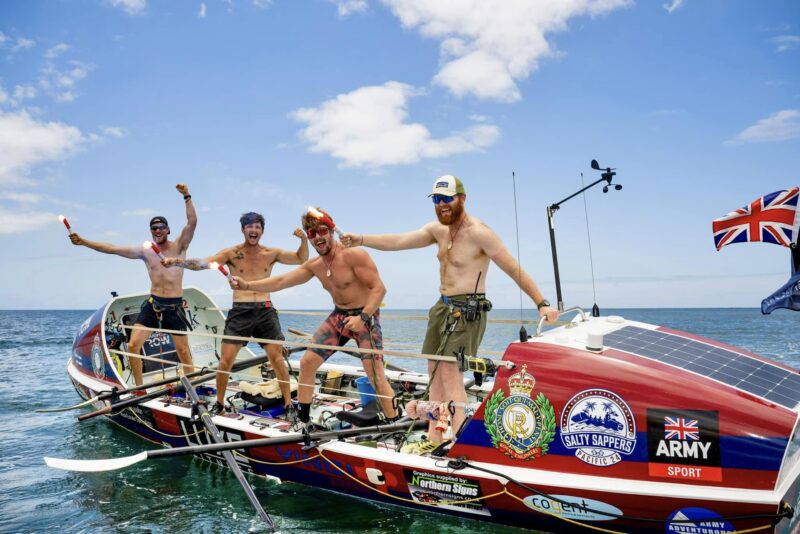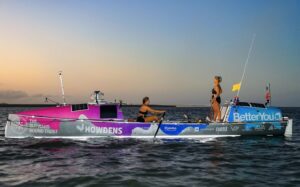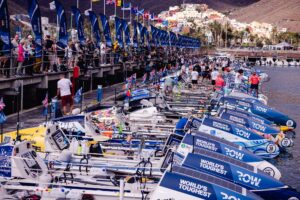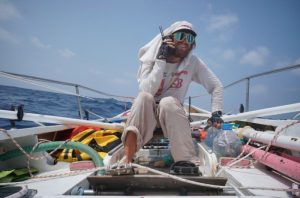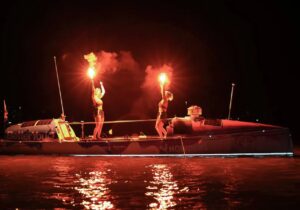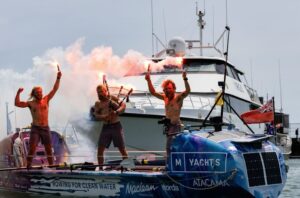Since our last ocean rowing roundup, all but one crew have finished The World’s Toughest Row. In addition, one party has abandoned its circumnavigation of Britain, and another is gearing up to complete a row of the Northwest Passage that they started last year.
Pacific Ocean
World’s Toughest Row: The World’s Toughest Row race began on June 8. Nine teams set off from Monterey, California to cross the mid-Pacific to Hanalei Bay, Hawaii. This year saw the highest number of female crews, seven of the initial nine. And despite pretty horrendous conditions, the women have been smashing speed records all over the place.
The conditions throughout the row have frustrated everyone, with many teams pushed off course by unexpected bad weather. The first few weeks had winds of over 30 knots and waves nearly 10 meters high. One crew pulled out after four days because of severe seasickness, and one member was even airlifted from the boat.
Every boat suffered multiple knockdowns, and most suffered several capsizes, leaving rowers with bruises and broken equipment. AIS and automatic steering failures meant that some crews had to steer manually and missed collisions by inches. Everything on the boats, including sleeping bags, was always soaking wet, making for quite a miserable time.
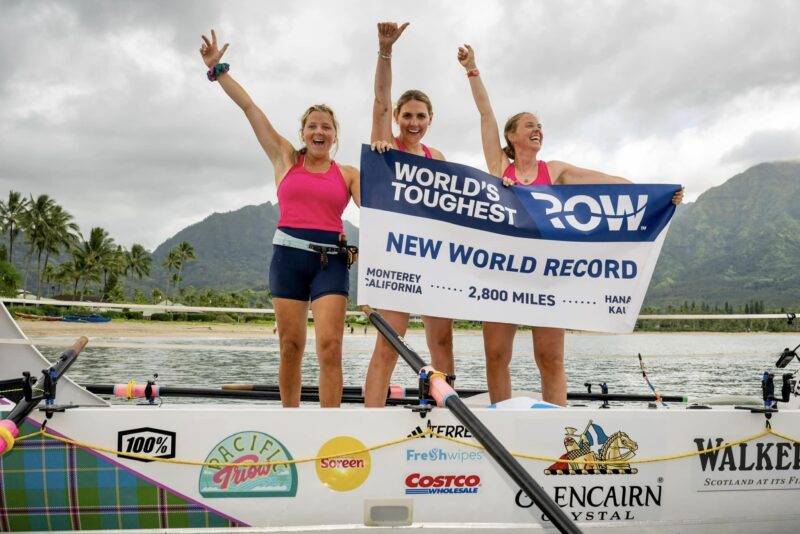
Pacific Triow. Photo: The World’s Toughest Row
So far, seven of the eight crews have crossed the finish line. The race winners were the four-man crew, the Salty Sappers. All engineers in the British Army — sappers is military slang for “engineers” — Major Adam Siggs, Captain Joshua Warne, Lance Corporal Richard Wilkinson, and Corporal Adam Sedgwick made it to Hanalei Bay in 36 days, 6 hours, and 49 minutes. After winning, they said that they would “live off the high for months.”
This means that British military crews have won both of the World’s Toughest Row races this year. In January, HMS Oardacious, made up of members of the Royal Navy, won the Atlantic version.
Two all-female crews broke speed records during the row. Both previously completed the Atlantic race, where they also broke records.
Wild Waves became the fastest women’s pair to cross the mid-Pacific, beating the previous record by a staggering nine days. Hilariously, when they first turned up for the Atlantic row years ago, they were one of the least experienced crews. They were also so drunk the day before starting they were almost banned from competing.
Yet in the end, they won the race by five days, beating 35 other crews. This time, they took it more seriously and said it was a much harder race.
“It was absolutely grueling, both [mentally and physically],” they said on the podium. “The hardest thing we have ever done. We gave it everything and are completely broken. But it was worth it.”
A day later, another women’s team, Pacific Triow, broke both the women’s and men’s speed records by 15 hours for a trio crossing the mid-Pacific. Their boat capsized three times, and their first two auto-helms melted because of the heat.
“The thought of the last remaining auto-helm breaking was a real worry,” Charlotte Irving told The Telegraph. “We had this constant level of anxiety that it would. The conditions were brutal, there were many tears….We had to be really resilient…but our goal was to break the world record, and we did that.”
Rumor has it that the two record-breaking female crews are now planning to team up and take on the Indian Ocean.
The leaderboard:
Overall Winners: Salty Sappers (Four) – 36 days, 6 hours, and 49 minutes.
2nd: Wild Waves (Pair) – 37 days, 11 hours, and 43 minutes (speed record: Fastest women’s pair to cross the Mid-Pacific).
3rd: Liz and Lena (Pair) – 37 days, 16 hours, and 33 minutes.
4th: Pacific Triow (Trio)– 38 days, 1 hour, and 34 minutes (speed record: Fastest trio to cross the Mid-Pacific).
5th: Full Foarce (Four) – 38 days, 9 hours, and 3 minutes.
6th: Hericane Rowing (Four) – 40 days, 22 hours, and 14 minutes
7th: Human Powered Potential (Four) – 41 days 1 hour, and 57 minutes
Ocean Revival: Ocean Revival’s current crew comprises Matt Mason, Will Scott, Mike Donovan, and Stephen McHugh. They are attempting to row across the Mid-Pacific from San Francisco to Hawaii.
The four started rowing on June 20. Kayaker Cyril Derreumaux ceremonially accompanied them as they set off.
In the first few days, they pushed against strong winds. Everyone except Scott suffered from seasickness. Despite this, their updates have been positive. Now, the easterly winds and swells are behind them, and their pace is increasing. Yesterday, they reached their halfway point.
Atlantic Ocean
Tom Waddington: Waddington is attempting to row across the North Atlantic from St. John’s, Newfoundland, Canada to Penzance, UK. The soloist started his journey on July 5 and is trying to break the 39-day speed record for the route.
Before this challenge, Waddington had never rowed, but he put in over 400 hours of training at sea.
On the first night, Waddington struggled to sleep despite the waves crashing against the boat. The anxious newbie kept jumping up to check that his oars had not fallen overboard. He soon got into a rhythm, though.
Mid-row, some curious long-finned pilot whales followed his boat. More whales kept joining the group. Eventually, around a thousand whales surrounded his little craft. The whales kept popping their heads out of the water, playing with each other and diving.
All of a sudden, one of the whales slammed into the side of his boat.
“And I was like, Oh my God,” Waddington commented on social media. “Suddenly, it turned from David Attenborough into Moby Dick. And I was really scared.”
Getting through a pod of a thousand whales is a daunting task. Waddington tried shouting and hitting his oars on the water to get them to move. The whales stayed exactly where they were, happy with their new play area. So he tried veering northward, out of the gam of whales. It worked, although some continued to follow him for two hours.
Waddington did not have an easy first few weeks because of consistently difficult conditions. Most of the time, it has been raining. Fog and mist have reduced visibility to an eerie few meters. Huge waves have slowed him down. He has had to row 16 hours a day to keep pace, only stopping to eat.
Around the UK
GB Row Challenge: In this race, two crews row clockwise around Great Britain, starting and ending at Tower Bridge in London. The row kicked off on June 9, in tricky conditions.
Within the first 10 days, both crews ended up at anchor because of gale-force winds along Britain’s south coast. Then, along the Cornish coast, they battled strong currents.
Coastal Odyssey has led Sea Change since the start of the race. Their lead has increased over time.
At the start of July, Coastal Odyssey made its way up the east coast of Ireland. However, strong winds forced them to hug the coastline, adding many extra kilometers. Sea Change also struggled against the unexpected winds and had to wait for a weather window to cross the Bristol Channel.
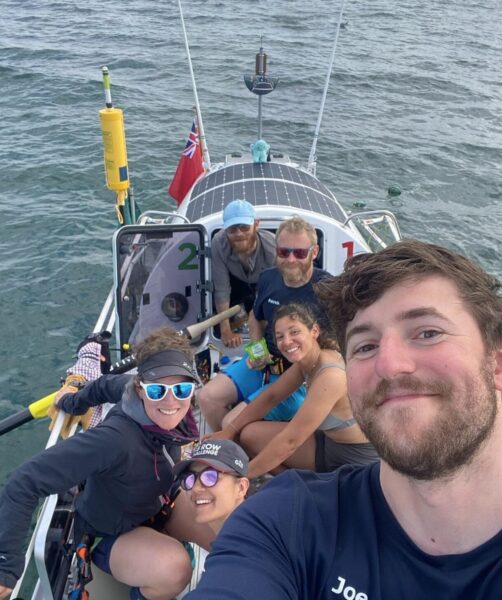
Photo: Coastal Odyssey
After 14 days stuck in a harbor on the south coast, Sea Change moved anchorage to cross the Bristol Channel. But then a squall hit, bearing winds of up to 105kph. The boat was damaged, with key safety features compromised. As Coastal Odyssey hit the halfway point, Sea Change pulled out.
Now a one-team race, Coastal Odyssey has made it around the top of Scotland and is heading down the east coast of Britain.
The Long Row Home: Allan Lipp and Mhairi Ross (UK) are also rowing clockwise around Great Britain, but they started from Wick in Scotland.
The row down the east coast of Britain has had some tricky moments. As they moved from Scotland to England, the long shifts left them exhausted and seasick. In some places, there was so little shelter from the swells that it felt like being trapped in a “washing machine on a cold cycle: moist, swooshy, and rolly,” they said.
Arriving in the Humber, they had to contend with busy shipping lanes.
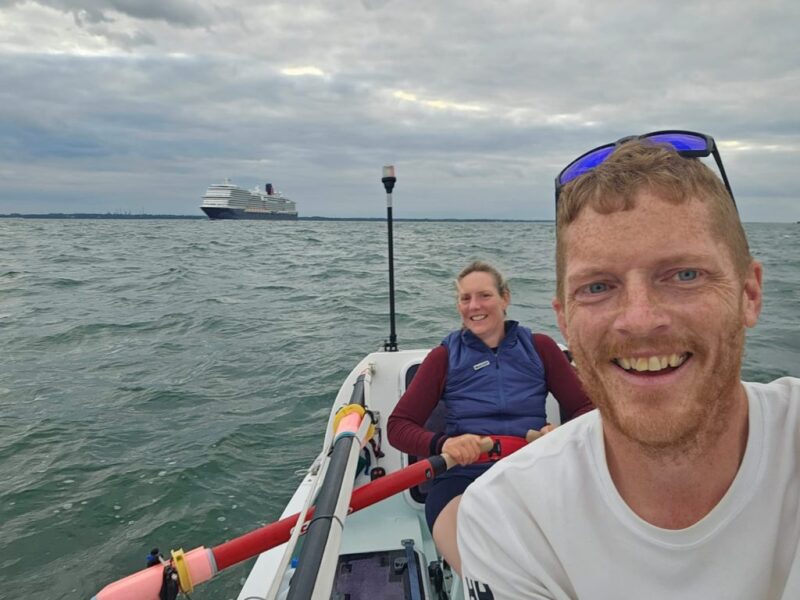
Photo: The Long Row Home
At the end of June, the weather changed completely. Rather than the rain and wind they had become used to, they found themselves in a heat wave. They adjusted to a one-hour on, one-hour off rotation to cope with the sweltering heat.
After 46 days at sea, they are just 90km from Lands’ End, the southwestern point of Britain.
Northwest Passage
NWP Expedition: This team first tried to traverse the Northwest Passage last year, but abandoned the attempt after 2,600km, deterred by the unstable fall weather.
Rather than attempt the entire journey again, they are returning to Cambridge Bay, where they ended their row last year. From there, they will row the final 1,100km of their original route to Point Burrow, Alaska.
Though the team uses the same name and is still led by Leven Brown, nearly all the other members have changed. Mike Harding is the only returning crew member, while Felix Petit, Stefan Hacker, and Art Huseonica joined the 2024 team. They are currently in Cambridge Bay.
